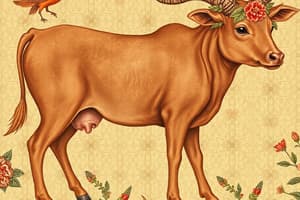Podcast
Questions and Answers
What is homeostasis in organisms?
What is homeostasis in organisms?
- The maintenance of internal conditions within a constant range (correct)
- An adaptation to improve reproductive success
- The ability to change internal conditions rapidly
- The process of converting sunlight into energy
How do polar bears maintain their body temperature in ice-covered regions?
How do polar bears maintain their body temperature in ice-covered regions?
- By producing additional body fat in warmer months
- By entering a state of hibernation to conserve energy
- By migrating to warmer areas during winter months
- By generating heat and reducing heat loss through thick fur (correct)
What is the source of energy used by the California condor for its metabolic activities?
What is the source of energy used by the California condor for its metabolic activities?
- Chemical energy from photosynthesis
- Decomposed organic matter in the environment
- Chemical energy derived from ingested food (correct)
- Solar energy captured through feathers
What defines evolutionary adaptation?
What defines evolutionary adaptation?
Which statement best describes the role of hormones in homeostasis?
Which statement best describes the role of hormones in homeostasis?
Study Notes
Homeostasis
- Organisms maintain a stable internal environment despite external changes.
- This is achieved through processes that regulate factors like temperature, pH, and nutrient levels.
- An example is the polar bear's ability to maintain body temperature in cold environments through insulation and heat generation.
Energy Processing
- All organisms require energy for metabolic activities.
- Organisms like plants capture energy from the sun through photosynthesis, converting it into chemical energy (food).
- Other organisms, like the California condor, obtain energy from consuming food and convert it through cellular respiration.
Evolutionary Adaptation
- This is a process where organisms develop changes in structure or behavior that allow them to better survive and reproduce in their environment.
- These changes are inherited and passed on to future generations.
- Adaptations are the result of natural selection, where individuals with advantageous traits are more likely to survive and reproduce.
Studying That Suits You
Use AI to generate personalized quizzes and flashcards to suit your learning preferences.
Description
Explore the concepts of homeostasis, energy processing, and evolutionary adaptation in organisms. Understand how living beings maintain stability, convert energy, and adapt to their environment through natural selection. This quiz covers key biological processes and examples.




